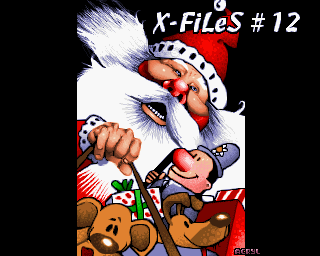Packs - A Glance at the Past
Today we have incredible fast Internet connections, harddrives with hundreds of gigabytes of storage space, CD's and DVD's and a lot of other fancy stuff. This hasn't always been the case. In the golden age of our beloved Amiga, things were quite different from what it is today. Nowadays, there isn't much hassle involved in getting all the productions that was released at a party. You just search around the web, and most probably, the releases will be available for download on multiple sites.Imagine if you hadn't got Internet access and no one you knew had it either. Maybe you and your friends didn't even have modems. As you can imagine, you would be pretty stuck when it came to getting hot new stuff.
In the early days of the Amiga, people traded stuff via ordinary snail-mail. People established contact with likeminded people around the globe and disks with demos, intros and other stuff was exchanged. The productions was accompanied by letters written on paper or as a textfile on one of the disks. Friends were made and connections established between different demo crews or people who was independent.
It is in this context that packs come in as an important factor. Many swappers had their own pack, and they stuffed it with hot new productions. Some of you may wonder what a pack exactly is, so I will try to give you a brief description.
There were many different kinds of them, but I will deal with the most common ones here.
First, we have the programmed pack. Those consisted of a programmed launcher with a graphical interface. They could be a bit similar to diskmags, only that the main focus was on the productions. Through such a pack you could view articles, news, messages or perhaps other stuff, along with launching the productions that was included. Two good examples are Speed from Nah-Kolor and Frozenpack from Whelpz.



Now, back to the topic. As you can read from the description, packs were extremely handy for swappers and other end-users alike. With them you could easily gather productions from a specific party without much trouble. Remember that harddrives wasn't a common piece of hardware on the Amiga in those days, so having an organized diskbox was an advantage. With packs you knew exactly were to find a certain intro, a special utilitity or maybe a game like Rick Dangerous.
As mentioned earlier, packs could contain articles as well as productions. Because of this, they became an important spreader and provider of news for the Demo Scene. You could read the latest gossip about many different groups or people or just keep yourself updated with the latest events. Beside this, messages from sceners was usually included. Many packs had a special section for this, where people could send in a textfile of messages to their contacts. Such stuff was always fun to read.
Last but not least, the all important advertisement section. Here you could find huge load of adverts where people searched for new contacts. If you were looking for more people to trade with, this section was the number one section to search. Many of the adverts had fancy ascii-logos, which made them look quite professional and inviting.
There is a lot more that could have been written about packs and all the history around them. We are planning more articles and insights into the Demo Scene here on www.classicamiga.com, so please check back with us later to see if more content has been added.
As mentioned earlier, packs could contain articles as well as productions. Because of this, they became an important spreader and provider of news for the Demo Scene. You could read the latest gossip about many different groups or people or just keep yourself updated with the latest events. Beside this, messages from sceners was usually included. Many packs had a special section for this, where people could send in a textfile of messages to their contacts. Such stuff was always fun to read.
Last but not least, the all important advertisement section. Here you could find huge load of adverts where people searched for new contacts. If you were looking for more people to trade with, this section was the number one section to search. Many of the adverts had fancy ascii-logos, which made them look quite professional and inviting.
There is a lot more that could have been written about packs and all the history around them. We are planning more articles and insights into the Demo Scene here on www.classicamiga.com, so please check back with us later to see if more content has been added.
PG
Set as favorite
Bookmark
Email This
Hits: 4132
Comments (0)

Write comment
You must be logged in to a comment. Please register if you do not have an account yet.
